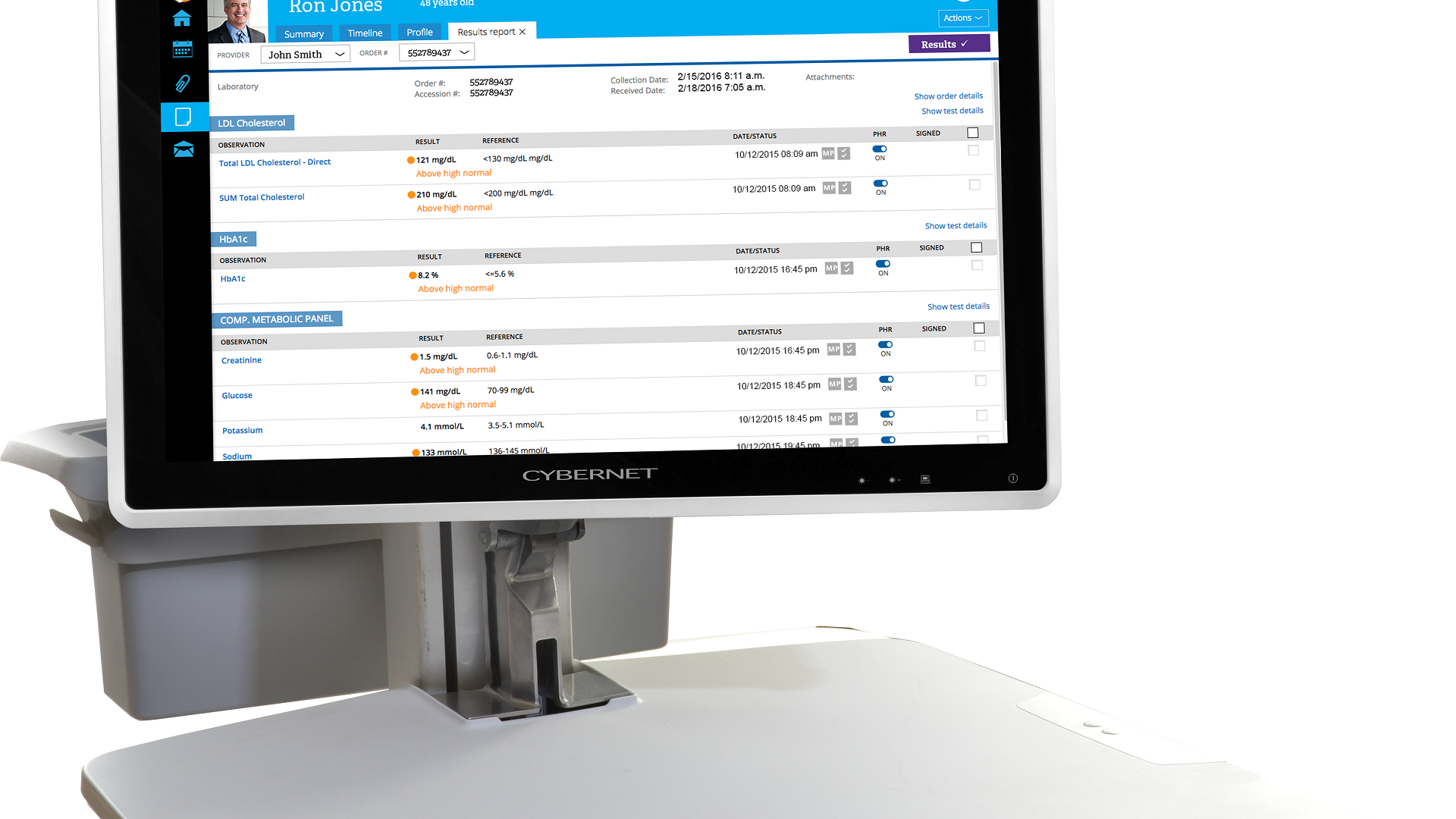Since their implementation, EHRs have been accepted into the healthcare space as a sort of necessary evil. The digital recording of patient notes is surely helpful and one of the many reasons we’re able to see the incorporation of new health initiatives like telehealth, yet, poor integration and interoperability plague EHR use, making it a major contributor to both physician and nurse burnout. And while healthcare optimized technology such as medical computers outfitted with ID authentication hardware has helped alleviate some of the nuisance behind repetitive logins, EHR compatibility issues and the subsequent burnout still run rampant.
Studies both past and present affirm this by making repeated links between staff resentments towards EHRs and their rates of burnout. According to a recent study published in the Journal of Informatics in Health and Biomedicine, clinicians who had to use EHRs after hours due to difficulties in taking notes on the software had nearly 5 times greater odds of experiencing high exhaustion on the job.
Unfortunately, this isn’t grounds enough to do away with EHRs as a whole. They simply provide too much benefit as opposed to the alternative of pen and paper. Although, while that may be the case, that doesn’t mean EHR workflow optimization can’t be sought after.
What Does EHR Workflow Optimization Look Like?
Article Guide
As the old adage goes, innovation is born from necessity. As hospitals accept that EHRs are here to stay and that, until interoperability and medical device connectivity are achieved, workarounds must be found, they’ve gone and done just that.
Today, as telehealth applications and massive restructuring of how patients are cared for abound, several facilities have begun embracing EHR customization in order to optimize their workflows. For the most part, this EHR customization has been predominantly achieved through third party solutions that improve usability.
This comes in staunch opposition to how many other facilities have chosen to “optimize” their EHR workflows” by simply ripping out their current EHRs and installing a new one in hopes of finding a better alternative. Replacing EHRs entirely is much more costly, making this process of throwing EHR providers at a wall until one sticks incredibly un-viable both financially and logically.
So, then, how effective is the alternative of EHR workflow optimization and EHR customization based on these third party solutions? Below are a few examples that have been proven successful and may just help your facility improve its own workflow.
Telehealth Integrations
Like we previously mentioned, telehealth is booming as the recent need for bolstered infection control in hospitals has accelerated its adoption. Naturally, this also resulted in a proportional jump in the adoption of telehealth-based EHR workflow optimization policies.
A very recent EHR-embedded telehealth tool by Athenahealth, for example, actually shows several facilities what an EHR optimized for remote care can look and function like! The third party software embeds perfectly into many popularly used EHR programs and provides a myriad of quality of life features such as the ability to start a facetime call with patients by simply clicking a button on their health record. This made manual dialing and meticulous page tracking between calls and patient records a thing of the past for a Massachusetts practitioner
Many times, burnout isn’t a result of the EHR breaking down, it’s a result of the excessive time it takes to juggle note-taking and speaking to a patient and giving them full attention. Telehealth integrations such as Athenahealth’s are one example of how an added EHR workflow optimization solution can cut down on these two pain points, enhance care, and even fight against physician EHR burnout rates.
Touchscreen Integration
Moving away from software-based solutions, touchscreen integration into the average physician’s workflow has also been proven to improve efficiency in care and patient record keeping. In today’s age, touch screens are as commonplace as food and water. Popular and regularly used devices such as smartphones and tablets are used even more frequently than desktop computers and workstations. Naturally this has given several professionals in the healthcare space some natural intuition when it comes to touchscreen use over keyboard and mouse use.
Studies have also illustrated this fact, one by Mitsubishi Electric Research Laboratories in particular explaining that their use improves response time by as much as 20%. These same benefits in response time and intuition can be elicited in EHR use as well. Investing in medical grade tablets with touch screen capabilities as portable workstations can empower clinicians with a touch-based solution to the perils of navigating several screens on a cluttered monitor with mouse and keyboard.
Again, the goal of EHR workflow optimization is to diminish time spent on the chart. Until bigger-scale changes are made to EHRs and how they communicate, cutting down on clicks and page clutter is the best way to do that.
Data Mapping Solutions
As far as interoperability is concerned in EHR use, one of the greatest roadblocks to proper collaboration, especially across separate care facilities, is the use of different terminology used to describe the same ailment, symptom, or treatment.
It doesn’t matter how well a patient’s record is kept by your staff if, once it’s sent off to another facility, that other team is unable to transfer it into their own EHR system or understand the terminology used by your team and visa-versa. Fortunately, there’s one more means of EHR workflow customization optimized towards improving clinical collaboration capabilities that would otherwise bring care efficiency to a halt.
Data Mapping is the process of cross-referencing different terminologies used by disparate care providers. Using data mapping solutions, records shared by a certain facility can be scanned for terminologies not in your system, but understood to be equivalent to other teams that are used by your system and swapped out. Not only does this make sharing EHR records easy and much quicker, it cuts down on confusion and misunderstandings that take time to rectify and, in more drastic situations, results in poor patient outcomes. Data mapping tools, if implemented into an EHR effectively, and if comprehensive enough, can cut down immensely on healthcare burnout by eliminating the need to meticulously scan and understand patient records.
Finding EHR Workflow Optimizations Tailored to Your Practice
While several effective EHR workflow optimization techniques are out there, it’s not as simple as just implementing every single solution you find. The most effective adopters of these solutions will be the ones who communicate with their teams and learn what optimizations work best to meet pain points across their staff. For more information on EHR workflow optimization solutions, contact an expert from Cybernet today.
Can Your Medical Computers Run Military Genesis EHR?
June 23, 2017
MHS Genesis EHR is now a reality. After four years of planning, months of tests and delays, and a $4.3-billion contract, Department of Defense’s first electronic health records implementation is live at Fairchild Air…
0 Comments10 Minutes
A Few Problems Medical Professionals Face with EHR Compatibility
January 30, 2020
According to HealthIt, more than 95% of hospitals and office-based physicians have started utilizing EHR software. It’s clear use of EHR software has become the majority standard in a decade. Medical professionals…
0 Comments10 Minutes
EHR Software: Benefits and Challenges for Medical Grade Computers
July 13, 2018
The rapid expansion of technological innovation has been keenly felt in the medical field. Healthcare providers now enjoy the benefits of new surgical tools, dedicated medical PCs, and high-end devices that make…
0 Comments8 Minutes
You Can't
Learn from a Pop-up
But we can deliver knowledge to your inbox!
We dive deep in the industry looking for new trends, technology, news, and updates. We're happy to share them with you.
Knowledge, News, and Industry Updates Right in Your Inbox





